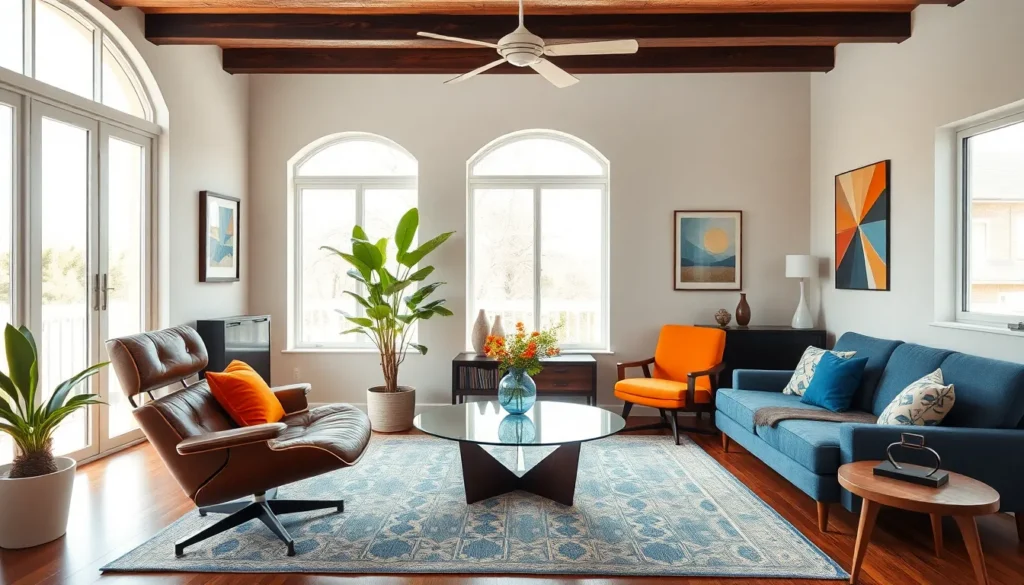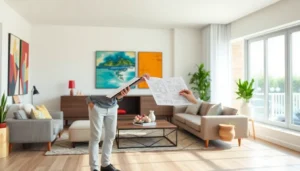Mid-Century Modern isn’t just a design style; it’s a lifestyle choice that screams sophistication and a hint of nostalgia. Picture this: sleek lines, vibrant colors, and furniture that looks like it could double as art. It’s the era where form met function in a glorious dance, and everyone was invited to the party.
Whether you’re a design aficionado or someone who just wants their living room to look like it belongs in a magazine, embracing Mid-Century Modern can transform any space. This style brings a playful yet polished vibe, making it perfect for those who appreciate the past while still wanting to keep things fresh. So grab a martini, kick back in your Eames chair, and let’s dive into the world of Mid-Century Modern—where every piece tells a story and style never goes out of fashion.
Overview of Mid-Century Modern
Mid-Century Modern emerged in the mid-20th century, becoming a prominent design movement. Its influence spans architecture, furniture, and interior design. Characterized by simplicity, it relies on clean lines and organic shapes. Bright, bold colors frequently play a key role, enhancing the aesthetic appeal of spaces.
Furniture designs prioritize function while maintaining artistic flair. Iconic pieces, such as the Eames lounge chair and the Noguchi table, demonstrate the perfect balance of form and practicality. Spaces embody openness, often featuring large windows that invite natural light indoors.
Materials used in Mid-Century Modern design include wood, metal, and glass, each contributing to a harmonious environment. Designers like Charles and Ray Eames and George Nelson revolutionized living spaces, making them accessible and inviting.
The style reflects a post-World War II mindset, emphasizing comfort and social interaction. People embraced the idea of merging indoor and outdoor living, creating seamless transitions between spaces.
Color schemes may include bright oranges, greens, and teals, contrasting with neutral tones. These combinations encourage vibrancy while grounded in sophistication.
Mid-Century Modern continues to inspire and resonate, maintaining relevance in contemporary design. Its versatility allows for integration with various styles, proving its timeless nature. Collectors and enthusiasts appreciate the history and craftsmanship tied to this design ethos, making it a cherished choice for many.
Key Characteristics

Mid-Century Modern design encompasses distinct attributes that exemplify its unique style. This category thrives on a balance between functionality and aesthetic appeal.
Design Elements
Clean lines define the architecture and furniture of this era. Curved forms blend seamlessly with geometric shapes, creating visual interest without complexity. Iconic pieces, like the Eames lounge chair, showcase craftsmanship and innovation. Minimalist silhouettes emphasize practicality, allowing space to flow freely. Natural materials, including wood and metal, enhance texture and warmth. Large windows invite the outdoors in, fostering a connection with nature. Overall, these design elements create a harmonious living environment that resonates with modern sensibilities.
Color Palette
Vibrant colors play a critical role in Mid-Century Modern aesthetics. Rich oranges, deep blues, and vivid greens emerge as common hues, adding energy to spaces. Earthy tones, such as browns and muted yellows, ground the palette and bring warmth. Contrasting shades often highlight furniture and accessories, drawing the eye to focal points. Designers strategically combine colors to evoke feelings of nostalgia while maintaining a fresh appeal. This dynamic color palette not only enhances visual interest but also reflects the cultural shifts of the mid-20th century, inviting a sense of joy and creativity into homes.
Influential Designers
Mid-Century Modern design owes much of its success to remarkable designers who shaped its trajectory. Two standout figures are Charles and Ray Eames, alongside George Nelson.
Charles and Ray Eames
Charles and Ray Eames revolutionized furniture design through innovative use of materials like molded plywood and fiberglass. Their iconic pieces, such as the Eames Lounge Chair and Eames Dining Chair, blend comfort with aesthetic appeal. Together, they believed in the importance of collaboration and experimentation, leading to their groundbreaking designs. The Eameses’ work emphasized functionality without sacrificing style, making their pieces timeless. Their influence extends beyond furniture to architecture, film, and textiles, establishing them as pivotal figures in Mid-Century Modern design.
George Nelson
George Nelson, another key influence, served as a prominent designer and architect within the movement. He championed the concept of “action furniture,” reflecting a playful and adaptable approach. Notable designs like the Nelson Bench and the Marshmallow Sofa showcase his ability to combine form with function. Beyond furniture, Nelson’s contributions included a commitment to modernist principles in architecture, emphasizing open spaces and light. His vision for design embraced creativity and intuitiveness, earning him a significant place in Mid-Century Modern history.
Iconic Mid-Century Modern Furniture
Mid-Century Modern furniture showcases bold personality and innovative design. It emphasizes comfort, functionality, and timeless beauty.
Chairs
Mid-Century Modern chairs often serve as statement pieces. The Eames Lounge Chair features molded plywood and leather, combining luxury and comfort seamlessly. Another standout, the Danish Design Egg Chair, offers a cocoon-like experience with its unique shape. Sculptural designs, like the Wire Chair by Harry Bertoia, play with form and negative space, inviting curiosity. Each chair reflects the era’s commitment to craftsmanship and artistic expression.
Tables
Tables from the Mid-Century Modern era exemplify simplicity and elegance. The Noguchi Table, with its organic shape, highlights the balance between art and function. Coffee tables often feature bold materials like glass and wood, ensuring they serve both practical and aesthetic purposes. The George Nelson Platform Bench serves dual roles, acting as both a seating option and a display surface. These iconic tables contribute to creating open, inviting spaces that resonate with the era’s design philosophy.
Impact on Contemporary Design
Mid-Century Modern design profoundly influences contemporary design, shaping aesthetics and user experiences. It inspires today’s interior designers to incorporate clean lines and functional furniture without sacrificing visual appeal. Current trends often blend vintage elements with modern sensibilities, showcasing the lasting legacy of this style.
Iconic pieces from the Mid-Century era remain sought-after in contemporary spaces. Chairs, such as the Eames Lounge Chair, continue to serve as focal points in modern living rooms, seamlessly bridging past and present. Additionally, the Noguchi Table’s sculptural form and practicality enhance both residential and commercial environments, proving that functionality can coexist with artistic expression.
Emerging designers often reference Mid-Century Modern principles while experimenting with new materials and technologies. Forms and silhouettes from this era reappear in innovative designs, reinforcing a commitment to both form and function. Sustainable practices, such as using reclaimed materials, reflect Mid-Century’s emphasis on quality craftsmanship, appealing to environmentally-conscious consumers.
Moreover, color palettes inspired by the Mid-Century aesthetic create inviting atmospheres in contemporary homes. Earthy tones combined with bold hues provide energy and warmth, echoing the optimism of the mid-20th century. Designers frequently use these colors to evoke emotion and create harmonious spaces, further connecting past influences to modern interpretations.
Contemporary architecture also showcases Mid-Century Modern elements, particularly in open floor plans and integration with nature. Large windows and airy structures encourage natural light, reminiscent of classic Mid-Century homes. This emphasis on indoor-outdoor living fosters connections between environments, enriching the overall experience of space.
Mid-Century Modern’s impact persists, as it continues to resonate with both collectors and new generations of design enthusiasts. Its principles transcend time, making it a vital reference point in the evolving landscape of contemporary design.
Mid-Century Modern design remains a powerful influence in today’s aesthetic landscape. Its unique blend of form and function continues to captivate those who appreciate both style and comfort. By integrating iconic pieces into contemporary spaces, individuals can create environments that reflect both nostalgia and modernity.
The movement’s emphasis on clean lines and vibrant colors invites creativity and warmth into homes, making it a timeless choice for design enthusiasts. As new generations discover this style, the legacy of Mid-Century Modern will undoubtedly endure, inspiring innovative approaches to living spaces for years to come.





